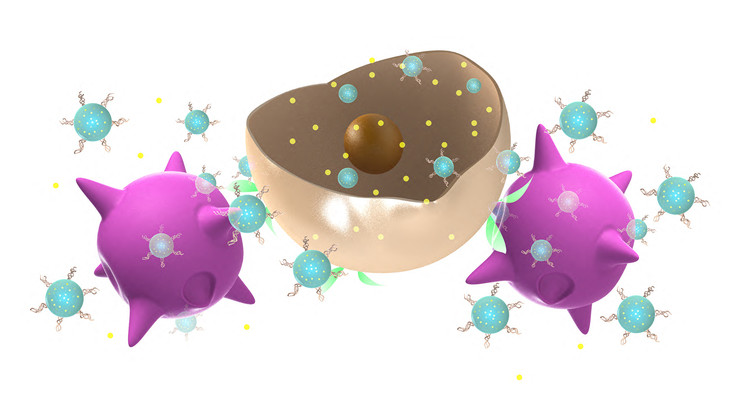
Artist’s conception of nanoparticle-carrying immune cells that target tumors and release drug-loaded nanoparticles for cancer treatment. Image: Jian Yang, Yixue Su/Penn State
Some researchers are working to discover new, safer ways to deliver cancer-fighting drugs to tumors without damaging healthy cells. Others are finding ways to boost the body’s own immune system to attack cancer cells. Researchers at Penn State have combined the two approaches by taking biodegradable polymer nanoparticles encapsulated with cancer-fighting drugs and incorporating them into immune cells to create a smart, targeted system to attack cancers of specific types.
“The traditional way to deliver drugs to tumors is to put the drug inside some type of nanoparticle and inject those particles into the bloodstream,” says Jian Yang, professor of biomedical engineering, Penn State. “Because the particles are so small, if they happen to reach the tumor site they have a chance of penetrating through the blood vessel wall because the vasculature of tumors is usually leaky.”
The odds of interacting with cancer cells can be improved by coating the outside of the nanoparticles with antibodies or certain proteins or peptides that will lock onto the cancer cell when they make contact. However, this is still a passive drug delivery technology. If the particle does not go to the tumor, there is no chance for it to bind and deliver the drug.
Yang and Cheng Dong, department head and distinguished professor of biomedical engineering, wanted a more active method of sending drugs to the cancer wherever it was located, whether circulating in the blood, the brain, or any of the other organs of the body.
“I have 10 years of working in immunology and cancer,” Dong says. “Jian is more a biomaterials scientist. He knows how to make the nanoparticles biodegradable. He knows how to modify the particles with surface chemistry, to decorate them with peptides or antibodies. His material is naturally fluorescent, so you can track the particles at the same time they are delivering the drug, a process called theranostics that combines therapy and diagnostics. On the other hand, I study the cancer microenvironment, and I have discovered that the microenvironment of the tumor generates kinds of inflammatory signals similar to what would happen if you had an infection.”
Immune cells, which were built to respond to inflammatory signals, will be naturally attracted to the tumor site. This makes immune cells a perfect active delivery system for Yang’s nanoparticles. The same technology is also likely to be effective for infectious or other diseases, as well as for tissue regeneration, Dong says.
In the first proof of their technology, the two research groups targeted circulating melanoma cells. In a paper published in the current online issue of the journal Small, titled “Immune Cell-Mediated Biodegradable Theranostic Nanoparticles for Melanoma Targeting,” the researchers report the use of a novel biodegradable and photoluminescent poly(lactic acid) nanoparticle, loaded with melanoma-specific drugs with immune cells as the nanoparticle carriers. They showed that the immune cells could bind to the melanoma cells under shear stress conditions similar to those in the bloodstream. These experiments were all performed in the laboratory. Next they intend to perform studies in animal models and in solid tumors.
“This is the first study and is just to show that the technology works,” Dong says. “This study is not about curing melanoma. There are probably other ways to do that. We used melanoma cells to validate the approach.”
In addition to corresponding authors Cheng Dong and Jian Yang, co-lead authors are Zhiwei Xie, postdoctoral scholar in Yang’s group, Yixue Su, a master’s student in Yang’s group, and Gloria Kim, a Ph.D. student advised by both Yang and Dong. Other contributors are Erhan Selvi, an undergraduate researcher in Dong’s lab, Chuying Ma, a Ph.D. student in Yang’s lab, Virginia Aragon-Sanabria, a Ph.D. student in Dong’s lab, and Jer-Tsong Hsieh, from the University of Texas Southwestern Medical Center.
The National Institutes of Health and the National Science Foundation supported this work. Both Dong and Yang are also associates of Penn State’s Materials Research Institute and the Huck Institutes of the Life Sciences.
Source: Penn State




